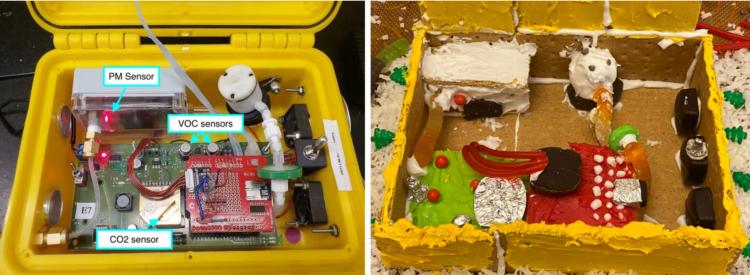Lab Technology
Sensor Pods
The Pods are an innovative technology designed by Mike Hannigan's Research Group at the University of Colorado Boulder through the support of the AirWaterGas Sustainability Research Network Education and Outreach Team. The purpose of the Pods is to create low cost air quality monitoring technologies for not only the use of the research team, but also for the use and education of the community. These Pods are very versatile and can be used inside as well as outside and may be used for stationary monitoring or can be battery powered for mobile monitoring. These Pods measure various pollutants including: carbon dioxide, carbon monoxide, particulate matter, total volatile organic compounds, nitrogen dioxide, and ozone. The Pods also measure temperature, relative humidity, wind data, and have GPS. The sensors that are used are a combination of metal oxide semi-conductors, electrochemical, and non-dispersive infrared. Data from the pod sensors are normalized to reference grade equipment using linear regression models and/or neural network machine learning.
Energy Systems Monitoring
Energy systems are fundamental to our daily lives. They provide essential services to users (e.g., transportation, heating, lighting, food, etc.) and in doing so, affect our environments. The Hannigan Lab has developed and deployed a suite of portable tools to measure direct emissions from everyday energy systems used in real-world settings and to quantify personal exposure to pollutants caused by these activities. The group has focused efforts on learning the extent to which disproportionately impacted communities worldwide face air quality concerns from inefficient and/or dirty energy systems like cookstoves, waste management, lighting, extractive processes, and transportation.
Source Apportionment Tools
In addition to measuring levels of air pollution with low-cost sensors, we seek to attribute these pollution levels to specific sources within a community. Our source apportionment tools include Chemical Mass Balance (CMB) and Positive Matrix Factorization (PMF). CMB and PMF use the equation shown below to attribute pollution to specific sources.

When we know the exact chemical makeup of the sources, CMB is an effective statistical method that solves the linear system of equations given from the mathematical framework shown in the image. CMB is most commonly used nearest the sources of pollution, where source compositions are known. When the number of sources or source compositions is not known, PMF provides a tool to determine both source composition and contribution, although the PMF solutions must be matched to real-world sources to be interpreted.

Left: The inside of a Y-Pod, developed by the Hannigan Lab. Right: The inside of a GingerPod, developed at the Hannigan Lab Holiday Party. Both models house PM, VOC, and CO2 sensors. (CO not shown). GingerPod sensors are not functional at this time.

A cook prepares TZ, a staple dish in northern Ghana, with the Phillips improved biomass cookstove while the research team monitors emissions from the process (credit: Nick Masson)

PMF results from FRAPPE show three sources: Combustion, Oil & Gas, and Natural Gas

